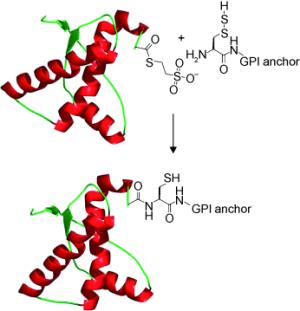|
Related Topics: |
|
|
|
Current News |
|
Chemistry A to Z |
|
About Internetchemistry |
Tracking Down the Cause of Mad Cow Disease |
|
The cause of diseases such as BSE in cattle and Creutzfeld–Jakob disease in humans is a prion protein. This protein attaches to cell membranes by way of an anchor made of sugar and lipid components (a glycosylphosphatidylinositol, GPI) anchor. The anchoring of the prions seems to have a strong influence on the transformation of the normal form of the protein into its pathogenic form, which causes scrapie and mad cow disease. A team headed by Christian F. W. Becker at the TU Munich and Peter H. Seeberger at the ETH Zurich has now “recreated” the first GPI-anchored prion in the laboratory. As they report in the journal Angewandte Chemie, they have been able to develop a new general method for the synthesis of anchored proteins. |
|
The isolation of a complete prion protein that includes the anchor has not yet been achieved, nor has it been possible to produce a synthetic GPI-anchored protein. The function of the GPI anchor has thus remained in the dark. A new synthetic technique has now provided an important breakthrough for the German and Swiss team of researchers. The sugar component of natural prion GPI anchors consists of five sugar building blocks, to which further sugars are attached through branches. Details of the lipid component have not been determined before. As a synthetic target, the researchers thus chose a construct made of the five sugars and one C18-lipid chain and worked out the corresponding synthetic route. First, the anchor was furnished with the sulfur-containing amino acid cysteine. The prion protein was produced with the use of bacteria and was given an additional thioester (a sulfur-containing group). The centerpiece of the new concept is the linkage of the protein and anchor by means of a native chemical ligation, in which the cysteine group reacts with the thioester. This allowed the prion protein to firmly attach to the vesicle membranes by way of the artificial anchor. This new concept will allow production of sufficient quantities of proteins modified with GPI anchors for in-depth studies. Experiments with the artificial GPI prion protein should help to clarify the influence of membrane association on conversion of the protein into the pathogenic scrapie form. This should finally make it possible to track down the infectious form of the prion. |
|
|
|

